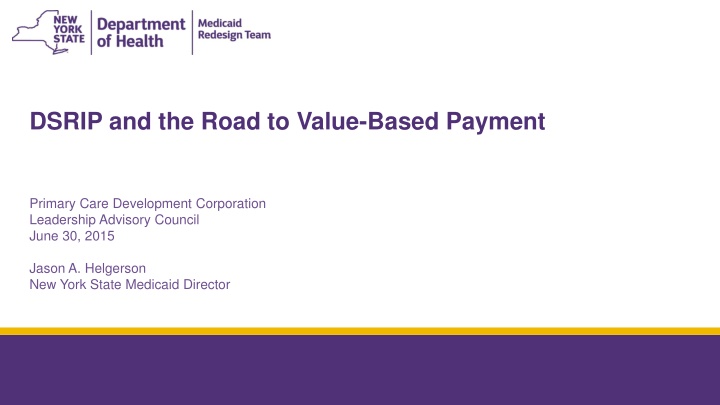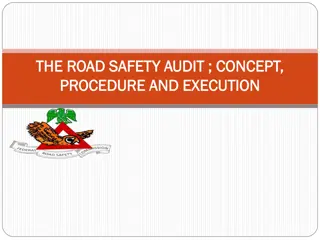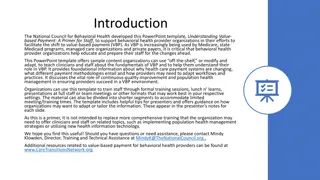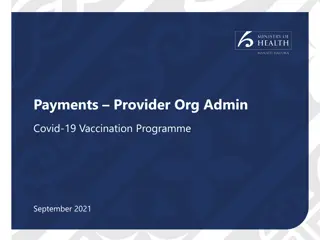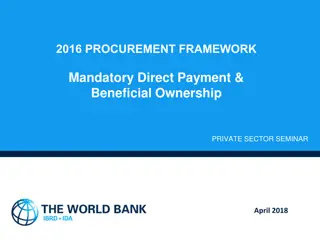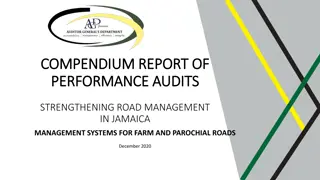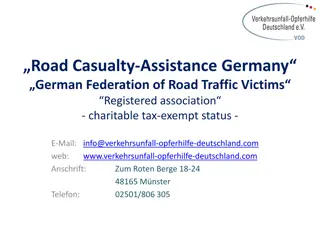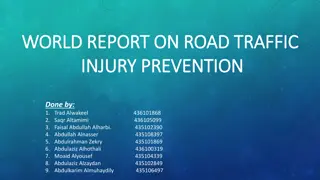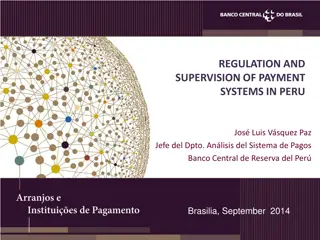DSRIP and the Road to Value-Based Payment
Background on New York State Medicaid's journey towards value-based payments, including the creation of the Medicaid Redesign Team in 2011 to address the crisis in 2010 and implement reforms tied to the Affordable Care Act.
Uploaded on Mar 14, 2025 | 2 Views
Download Presentation

Please find below an Image/Link to download the presentation.
The content on the website is provided AS IS for your information and personal use only. It may not be sold, licensed, or shared on other websites without obtaining consent from the author.If you encounter any issues during the download, it is possible that the publisher has removed the file from their server.
You are allowed to download the files provided on this website for personal or commercial use, subject to the condition that they are used lawfully. All files are the property of their respective owners.
The content on the website is provided AS IS for your information and personal use only. It may not be sold, licensed, or shared on other websites without obtaining consent from the author.
E N D
Presentation Transcript
DSRIP and the Road to Value-Based Payment Primary Care Development Corporation Leadership Advisory Council June 30, 2015 Jason A. Helgerson New York State Medicaid Director
2 Overview Background and Brief History Delivery System Reform and Payment Reform: two sides of the same coin NYS Medicaid Payment Reform brief overview NYS Medicaid Payment Reform policy levers and strategy
3 New York State Medicaid Approximately 6 million individuals in New York State are Medicaid beneficiaries (ranking 2nd in the nation, after CA) Current Medicaid spend in New York is approximately $59 billion annually (also 2nd in nation)
4 NYS Medicaid in 2010: the crisis 2009 Commonwealth State Scorecard on Health System Performance > 13% anticipated growth rate had become unsustainable, while quality outcomes were lagging NATIONAL RANKING CARE MEASURE 50th Avoidable Hospital Use and Cost Costs per recipient were double the national average NY ranks 50th in country for avoidable hospital use 21st for overall Health System Quality 49th 34th 35th 40th 50th Percent home health patients with a hospital admission Percent nursing home residents with a hospital admission Hospital admissions for pediatric asthma Medicare ambulatory sensitive condition admissions Medicare hospital length of stay Attempts to address situation had failed due to divisive political culture around Medicaid and lack of clear strategy
5 Creation of Medicaid Redesign Team A Major Step Forward In 2011, Governor Cuomo created the Medicaid Redesign Team (MRT). Made up of 27 stakeholders representing every sector of healthcare delivery system Developed a series of recommendations to lower immediate spending and propose reforms Closely tied to implementation of ACA in NYS The MRT developed a multi-year action plan we are still implementing that plan today
6 Key Components of MRT Reforms Global Spending Cap Introduced fiscal discipline, transparency and accountability Limit total Medicaid spending growth to 10 yr average rate for the long-term medical component of the Consumer Price Index (currently estimated at 3.8 percent). Care Management for All NYS Medicaid was still largely FFS; moving Medicaid beneficiaries to managed care helped contain cost growth and introduced core principles of care management Patient Centered Medical Homes and Health Homes Stimulating PCMH development and invest in care coordination for high-risk and high- cost patients through the NYS Health Homes Program Targeting the Social Determinants of Health Address issues such as housing and health disparities through innovative strategies (e.g. supportive housing.)
7 Medicaid Redesign Initiatives Have Successfully reduced costs NYS Statewide Total Medicaid Spending (CY2003-2014) $55 Projected Spending Absent MRT Initiatives * $50 $45 Tot. MA Spending (Billions) 2011 MRT Actions Implemented $40 $35 $30 2003 2004 2005 2006 2007 2008 2009 2010 2011 2012 2013 2014 Calendar Year 2003 2004 2005 2006 2007 2008 2009 2010 2011 2012 2013 2014 # of 4,267,573 4,594,667 4,733,617 4,730,167 4,622,782 4,657,242 4,911,408 5,212,444 5,398,722 5,598,237 5,805,282 6,311,762 Recipients Cost per Recipient $8,469 $8,472 $8,620 $8,607 $9,113 $9,499 $9,574 $9,443 $9,257 $8,884 $8,520 $8,223
8 Medicaid Redesign Initiatives Have Successfully Brought Back Medicaid Spending per Beneficiary to 2003 Levels $10,000 $9,500 Tot. MA Spending per recipient $9,000 $8,500 2011 MRT Actions Implemented $8,000 2003 2004 2005 2006 2007 2008 2009 2010 2011 2012 2013 2014 Calendar Year 2003 2004 2005 2006 2007 2008 2009 2010 2011 2012 2013 2014 # of 4,267,573 4,594,667 4,733,617 4,730,167 4,622,782 4,657,242 4,911,408 5,212,444 5,398,722 5,598,237 5,805,282 6,311,762 Recipients Cost per Recipient $8,469 $8,472 $8,620 $8,607 $9,113 $9,499 $9,574 $9,443 $9,257 $8,884 $8,520 $8,223 Source: NYS DOH OHIP DataMart (based on claims paid through April 2015)
9 The 2014 MRT Waiver Amendment Continues to further New York State s Goals Part of the MRT plan was to obtain a 1115 Waiver which would reinvest MRT generated federal savings back into New York s health care delivery system In April 2014, New York State and CMS finalized agreement Waiver Amendment Allows the State to reinvest $8 billion of $17.1 billion in Federal savings generated by MRT reforms $7 billion is designated for Delivery System Reform Incentive Payment Program (DSRIP) The waiver will: Transform the State s Health Care System Bend the Medicaid Cost Curve Assure Access to Quality Care for all Medicaid Members Create a financial sustainable Safety Net infrastructure
10 The DSRIP Challenge Transforming the Delivery System Largest effort to transform the NYS Medicaid Healthcare Delivery System to date From fragmented and overly focused on inpatient care towards integrated and community focused From a re-active, provider-focused system to a pro-active, patient-focused system Allow providers to invest in changing their business models Improving patient care & experience through a moreefficient, patient-centered and coordinated system. Patient-Centered Decision making process takes place in the public eye and that processes are clear and aligned across providers. Transparent Collaborative process reflects the needs of the communities and inputs of stakeholders. Collaborative Providers are held to common performance standards and timelines; funding is directly tied to reaching program goals. Accountable Focus on increasing value to patients, community, payers and other stakeholders. Value Driven
11 Over 5 Years, 25 Performing Provider Systems (PPS) Will Receive Funding to Drive Change A PPS is composed of regionally collaborating providers who will implement DSRIP projects over a 5-year period and beyond Each PPS must include providers to form an entire continuum of care Hospitals PCPs, Health Homes Skilled Nursing Facilities (SNF) Clinics & FQHCs Behavioral Health Providers Home Care Agencies Community Based Organizations Statewide goal: 25% of avoidable hospital use ((re-) admissions and ER visits) No more providers needing financial state-aid to survive Current State Work in progress RESPONSIBILITIES MUST INCLUDE: Community health care needs assessment based on multi-stakeholder input and objective data Implementing a DSRIP Project Plan based upon the needs assessment in alignment with DSRIP strategies Meeting and Reporting on DSRIP Project Plan process and outcome milestones
12 Delivery Reform and Payment Reform: Two Sides of the Same Coin A thorough transformation of the delivery system can only become and remain successful when the payment system is transformed as well Financial and regulatory incentives drive Many of NYS system s problems (fragmentation, high re-admission rates) are rooted in how the State pays for services a delivery system which realizes - FFS pays for inputs rather than outcome; an avoidable readmission is rewarded more than a successful transition to integrated home care - Current payment systems do not adequately incentivize prevention, coordination or integration cost efficiency and quality outcomes: value
13 NYS Medicaid Payment Reform: A Brief Overview
14 Healthcare CEO s show strong support for Value Based Payments 78% of top Healthcare CEO s polled by Modern Healthcare indicated that VBP should play the dominant role in reimbursement. VBP Should Play a Dominant Role Everybody feels that the days of fee for service are coming to an end; We need to bring everyone together. We need one glide path. Dr. Ram Raju President of NYC Health and Hospitals Corporation Agree Disagree *CEO Power Panel Shows Broad Support for VBP, Modern Healthcare
15 Healthcare leaders anticipate a positive impact on quality from Value Based Payments 93% of CEO s that were polled believe that the quality of care delivered to Americans will improve with value based payments. The Impact of VBP on Quality Stay about the Same 7% A lot of Improvement 40% I don t see our current system leading to better care. This certainly isn t a slow evolution. Right now, I think we re bordering on a revolution. Dr. Joseph Vasille Some Improvement 53% CEO of the Greater Rochester Independent Practice Association *CEO Power Panel Shows Broad Support for VBP, Modern Healthcare
16 Payment Reform: Moving Towards Value Based Payments By DSRIP Year 5 (2019), all Managed Care Organizations must employ non-fee-for- service payment systems that reward value over volume for at least 80-90% of their provider payments (outlined in the Special Terms and Conditions of the waiver) A Five-Year Roadmap outlining how NYS aims to achieve this goal was required by the MRT Waiver early May The State and CMS are committed to the Roadmap Core Stakeholders (providers, MCOs, unions, patient organizations) have actively collaborated in the creation of the Roadmap If Roadmap goals are not met, overall DSRIP dollars from CMS to NYS will be significantly reduced
17 Learning from Earlier Attempts: VBP as the Path to a Stronger System VBP arrangements are not intended primarily to save money for the State, but to allow providers to increase their margins by realizing value Goal Pay for Value not Volume
18 The VBP Roadmap starts from DSRIP Vision on How an Integrated Delivery System should Function Maternity Care (including first month of baby) Acute Stroke (incl. post-acute phase) Depression Episodic Integrated Physical & Behavioral Primary Care Chronic care (Diabetes, CHF, Hypertension, Asthma, Depression, Bipolar ) Includes social services interventions and community-based prevention activities Chronic Kidney Disease Continuous AIDS/HIV Multimorbid disabled / frail elderly (MLTC/FIDA population) Severe BH/SUD conditions (HARP population) Developmentally Disabled population Sub-population focus on Outcomes and Costs within sub-population/episode Population Health focus on overall Outcomes and total Costs of Care
19 The Path towards Payment Reform: A Menu of Options There is not one path towards Value Based Payments. Rather, there will be a variety of options that MCOs and PPSs/providers can jointly choose from. PPSs and MCOs can opt for different shared savings/risk arrangements (often building on already existing MCO/provider initiatives): For the total care for the total attributed population of the PPS (or part thereof) ACO model Per integrated service for specific condition (acute or chronic bundle): maternity care; diabetes care For integrated Advanced Primary Care (APC) For the total care for a subpopulation: HIV/AIDS care; care for patients with severe behavioral health needs and comorbidities Maternity Care (including first month of baby) Acute Stroke (incl. post-acute phase) MCOs and PPSs may choose to make shared savings arrangements for the latter types of services between MCOs and groups of providers within the PPS rather than between MCO and PPS Depression Integrated Physical & Behavioral Primary Care Chronic care Includes social services interventions and community- based prevention activities (Diabetes, CHF, Hypertension, Asthma, Depression ) Hemophilia AIDS/HIV Chronic Kidney Disease Multimorbid disabled / frail elderly (FIDA population) Severe BH/SUD conditions (HARP population) Care for the Developmentally Disabled
19 Focus on Primary Care: A Menu of Options Patient Centered Medical Homes (PCMH) or Advance Primary Care (APC) arrangements would reimburse based on the savings and quality outcomes they achieved. Savings would be focused primarily on so-called downstream costs: expenditures across the total spectrum of care that would be reduced when the PCMHs/APCs would be functioning optimally. Avoidable ED visits and hospital admissions for conditions such as diabetes and asthma are good examples. The quality outcomes would be those DSRIP Domain 2 and 3 metrics attributable to integrated primary care, including the behavioral health, diabetes, asthma and cardiovascular health metrics.
20 MCOs and PPSs can choose different levels of Value Based Payments In addition to choosing what integrated services to focus on, the MCOs and PPSs can choose different levels of Value Based Payments: Level 0 VBP Level 1 VBP Level 2 VBP Level 3 VBP (only feasible after experience with Level 2; requires mature PPS) FFS with bonus and/or withhold based on quality scores FFS with upside-only shared savings available when outcome scores are sufficient (For PCMH/APC, FFS may be complemented with PMPM subsidy) FFS with risk sharing (upside available when outcome scores are sufficient) Prospective capitation PMPM or Bundle (with outcome-based component) Goal of 80-90% of total MCO-provider payments (in terms of total dollars) to be captured in Level 1 VBPs at end of DY5 Aim of 50% of total costs captured in VBPs in Level 2 VBPs or higher
21 NYS Medicaid Payment Reform: Policy Levers and Strategy
22 Key Defining Factors our the New York VBP Approach 1. Addressing all of the Medicaid program in a holistic, all-encompassing approach rather than pilots or individual VBP projects without overall framework 2. Leveraging the Managed Care Organizations (MCO) to deliver the payment reforms 3. Avoiding negative financial incentives for stakeholders moving towards VBP 4. Allowing for maximum flexibility in the implementation for stakeholders, while maintaining a robust, standardized framework 5. Maximum focus on transparency of costs and outcomes of care
28 Questions?
29 Additional information available at: https://www.health.ny.gov/health_care/medicaid/redesign/dsrip/ DSRIP e-mail: dsrip@health.ny.gov
